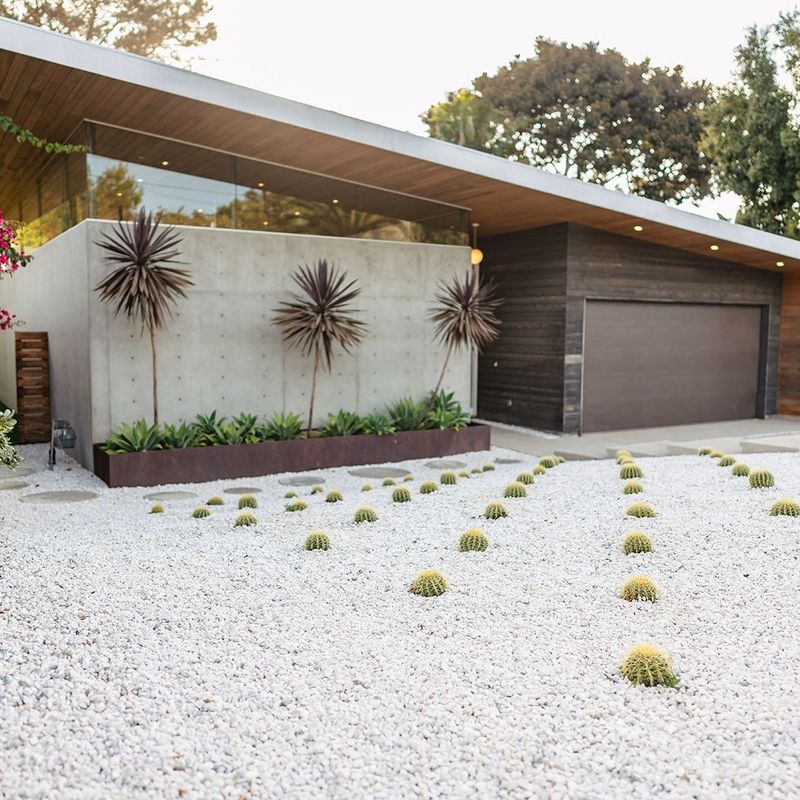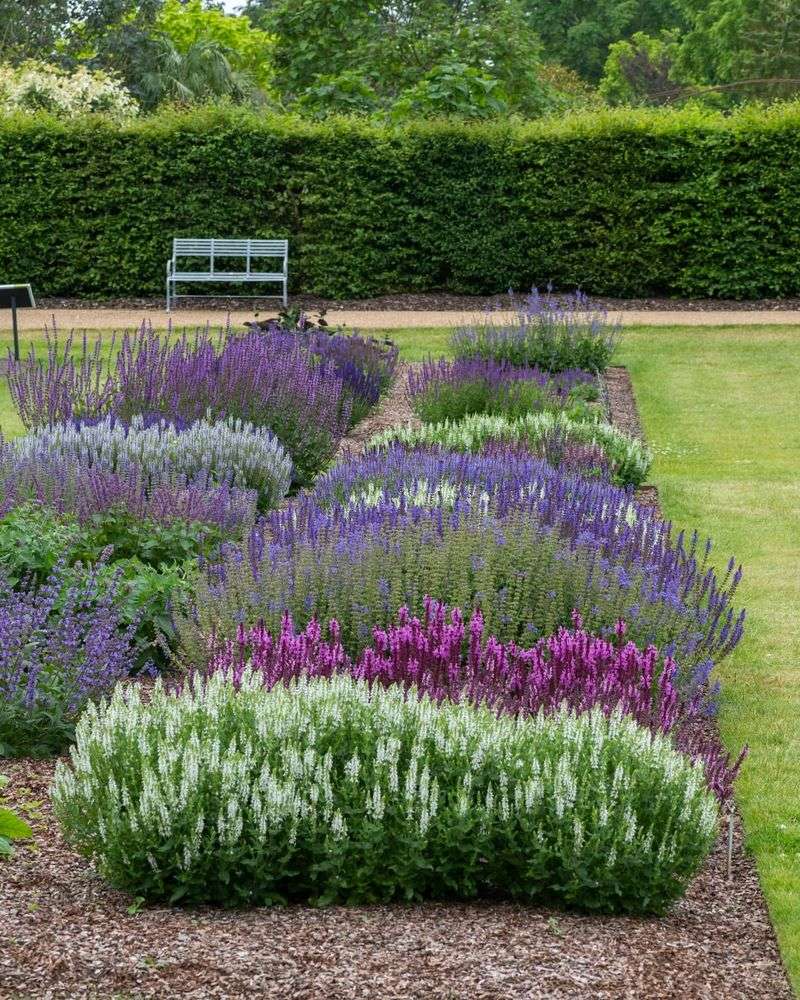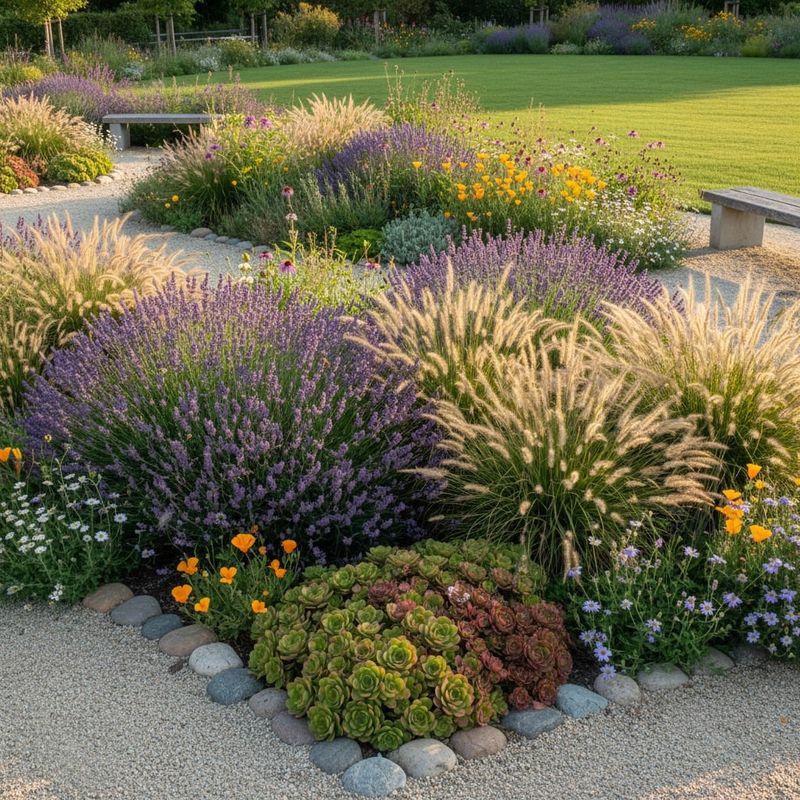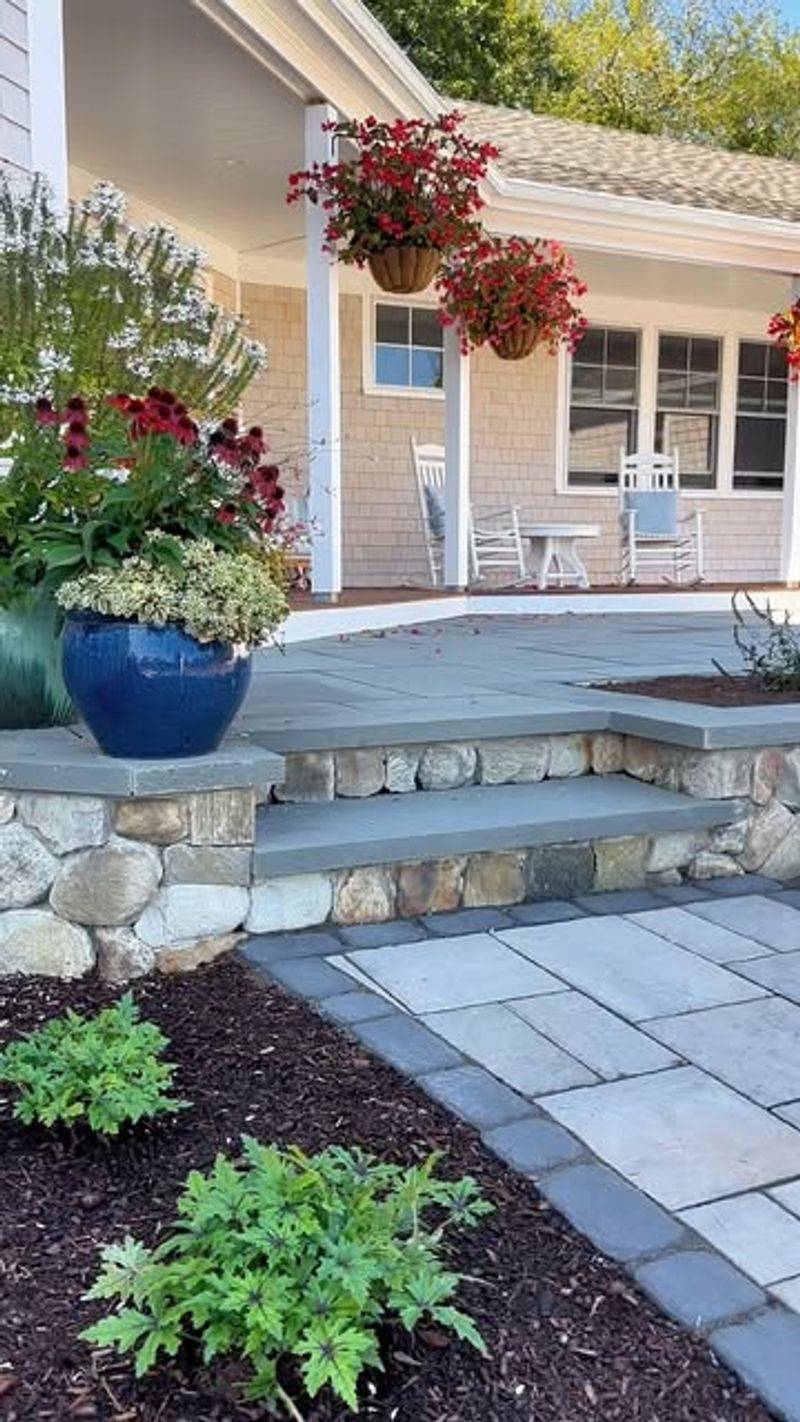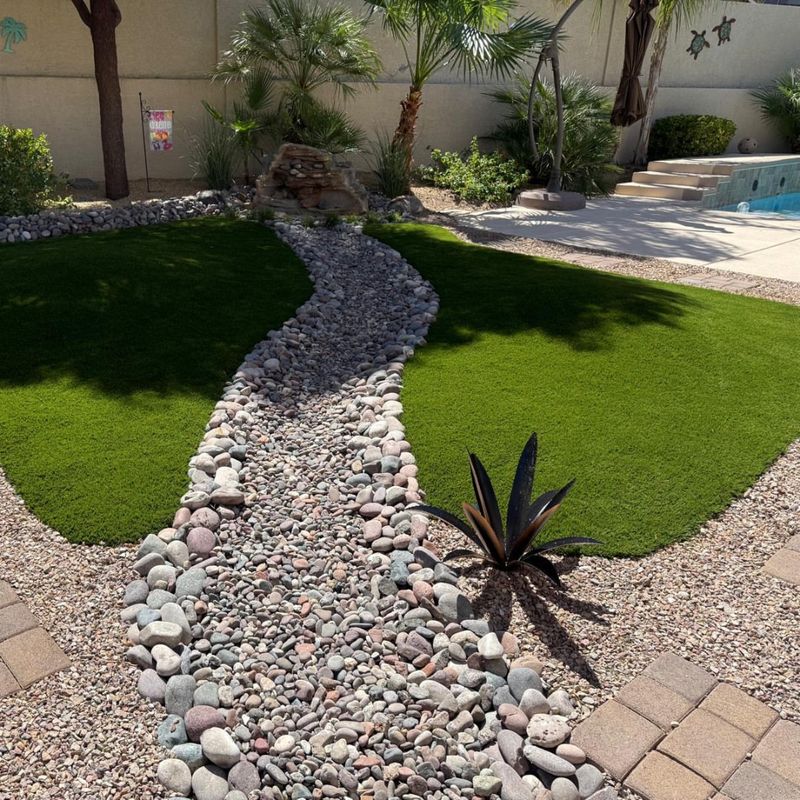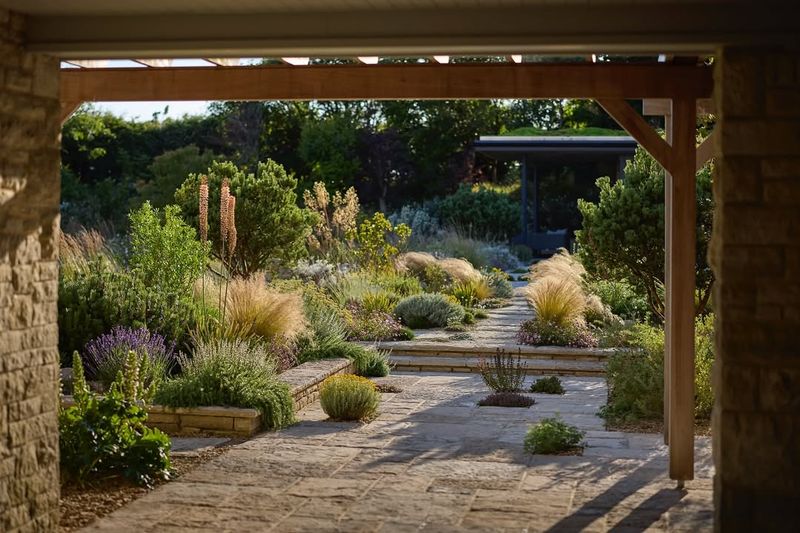Zero water landscaping is taking off because people are finally tired of babysitting grass that refuses to stay green no matter how much effort they throw at it.
There’s a real appeal in swapping constant watering and maintenance for a clean, stylish yard that holds up on its own all year long.
The whole trend feels like a breath of relief for anyone who wants something beautiful outside without turning it into a second full-time job.
Why Homeowners Are Finally Done Babysitting Thirsty Lawns
Last summer my neighbor spent every single evening dragging hoses around his yard trying to keep his grass from turning completely brown and crispy.
Watching him work so hard just to maintain something that fights nature every step of the way made me realize how exhausting traditional lawns can actually be.
Traditional grass demands constant attention with weekly mowing, fertilizing, weeding, and of course watering that can use thousands of gallons every single month during hot weather.
Many homeowners are finally realizing that this endless cycle of maintenance eats up their precious free time and drains their wallets with rising water bills year after year.
Zero water landscaping offers a refreshing escape from this never ending routine by replacing demanding turf with beautiful alternatives that thrive naturally in your local climate conditions.
Once you make the switch your weekends open up for things you actually enjoy instead of being stuck doing repetitive yard chores that feel like punishment.
The Gravel And Stone Designs Making Yards Look Clean And Modern
Walking through my friend’s neighborhood last month I noticed her front yard looked like something straight out of a design magazine with its gorgeous stone pathways.
Gravel and stone have become the backbone of many zero water landscapes because they create instant visual interest while requiring absolutely zero maintenance or water resources.
River rocks in shades of gray, tan, and rust can be arranged in flowing patterns that guide the eye through your yard creating natural movement.
Decomposed granite offers a softer walking surface that packs down firmly over time and comes in warm earthy colors that complement almost any architectural style beautifully.
Larger boulders can serve as dramatic focal points or natural seating areas that anchor your design and add a sculptural quality to otherwise flat outdoor spaces.
The clean lines and neutral tones of stone-based designs give homes an updated contemporary feel that never goes out of style or needs seasonal refreshing.
Low-Water Plants Stealing The Spotlight In Hotter States
Driving through Arizona last spring I was amazed by how many front yards were bursting with color from plants that need practically no water at all.
Succulents like agave and aloe create bold architectural shapes with their thick fleshy leaves that store water efficiently and look stunning year round in arrangements.
Native plants such as lavender, sage, and ornamental grasses have adapted perfectly to local conditions over thousands of years and attract beautiful butterflies and hummingbirds naturally.
Cacti come in an incredible variety of shapes and sizes from tall saguaros to round barrel types and many produce surprisingly vibrant flowers during blooming seasons.
These drought-tolerant superstars thrive in hot sunny conditions where traditional garden plants would wilt and struggle requiring constant intervention to simply survive the summer months.
Once established in your yard these hardy beauties actually prefer being left alone and can look fuller and healthier than any high-maintenance garden ever could.
How People Are Cutting Their Water Bills Without Sacrificing Style
My cousin switched to zero water landscaping two years ago and she told me her summer water bills dropped by more than half almost immediately.
Traditional lawns can guzzle between seven thousand and fifteen thousand gallons of water each month during peak summer heat which translates to hundreds of dollars yearly.
Removing thirsty grass and replacing it with gravel, native plants, and efficient designs eliminates this massive water consumption while still creating an attractive outdoor space you love.
Many cities and water districts now offer rebates or cash incentives for homeowners who convert their lawns to drought-friendly landscapes making the initial investment even easier.
The money you save on reduced watering can be redirected toward fun outdoor furniture, landscape lighting, or other upgrades that actually enhance your enjoyment of the space.
Best of all these savings continue year after year making zero water landscaping one of the smartest financial decisions you can make for your home long term.
The Drought-Friendly Trend Spreading From Desert Homes To Suburbs
What started as a practical necessity in desert regions like Nevada and Southern California has now become a popular choice even in areas with regular rainfall.
Homeowners in traditionally green states are discovering that drought-friendly landscaping makes sense regardless of climate because it saves time, money, and precious natural resources everywhere.
Suburban neighborhoods that once looked identical with matching green lawns now showcase creative individuality through unique stone patterns, plant combinations, and personal design touches that reflect personalities.
This shift represents a broader cultural change where people value sustainability and practicality over outdated ideas about what a proper yard should look like traditionally.
Social media has accelerated this trend by allowing people to share inspiring photos of their zero water transformations encouraging others to consider making similar changes.
Even homeowner associations that once strictly required grass lawns are updating their rules to allow or even encourage water-wise landscaping as environmental awareness grows nationwide.
Simple Swaps That Turn High-Maintenance Lawns Into Easy Care Zones
Transforming your yard does not have to mean ripping everything out at once or spending a fortune on a complete professional overhaul right away.
Start small by replacing the strip of grass along your driveway or sidewalk with decorative gravel and a few drought-tolerant plants to test the look.
Shrinking your lawn gradually over several seasons allows you to spread out costs while learning what plants and materials work best in your specific yard conditions.
Mulch pathways with wood chips or decomposed granite instead of maintaining grass in narrow areas where mowers barely fit and grass struggles to grow thick anyway.
Group plants with similar water needs together so you can focus any necessary watering in just one small zone rather than sprinkling your entire property wastefully.
Each simple swap you make reduces your overall maintenance burden and water consumption while moving you closer to a completely carefree outdoor space that practically takes care of itself.
The No-Sprinkler Look Everyone Says Feels Surprisingly Relaxing
Something about walking into a zero water landscape feels calmer and more peaceful than standing in a yard with sprinklers hissing and puddles forming everywhere.
Without the constant noise of irrigation systems or the visual clutter of hoses and sprinkler heads the space takes on an almost meditative quality that invites relaxation.
Natural materials like stone and wood create organic textures that feel grounding and timeless rather than overly manicured or artificially maintained like perfectly trimmed grass.
Many people report feeling less stressed about their outdoor spaces once they switch because there is no nagging worry about watering schedules or brown spots appearing.
The simplicity of a well-designed zero water yard allows you to actually enjoy being outside instead of constantly thinking about the next maintenance task waiting.
This relaxed aesthetic works beautifully with outdoor seating areas where you can sit and unwind surrounded by natural beauty that requires nothing from you in return.
Creative Layouts That Make Dry Gardens Feel Alive And Intentional
The best zero water landscapes do not look bare or neglected but instead feel carefully planned with every element placed exactly where it belongs purposefully.
Creating layers with plants of different heights adds depth and dimension that draws your eye through the space discovering new details with each glance around.
Curved pathways made from stepping stones or gravel lead visitors on a journey through your yard rather than straight boring lines that feel rigid and uninviting.
Repeating certain plants or colors throughout your design creates visual rhythm and unity that ties everything together into one cohesive attractive composition that feels professional.
Adding unexpected elements like decorative pottery, driftwood, or metal sculptures gives your yard personality and serves as conversation starters when guests visit your home.
Thoughtful lighting can highlight your favorite plants or architectural features at night transforming your zero water landscape into an entirely different magical experience after sunset falls.
The Texture-Heavy Styles Giving Front Yards A Fresh New Identity
One thing I love about zero water landscaping is how it celebrates different textures in ways that traditional grass lawns simply cannot match or compete with.
Combining smooth polished river stones with rough weathered boulders creates contrast that makes both materials stand out and look more interesting than either would alone.
Spiky plants like yucca or ornamental grasses add vertical drama and movement when breezes blow through while soft silvery plants like dusty miller provide gentle visual relief.
Chunky bark mulch offers a completely different texture than fine decomposed granite giving you options to define separate areas within your overall landscape design scheme.
Even hardscape materials like flagstone pavers or concrete stepping stones contribute their own unique surface qualities that invite closer inspection and add visual richness to compositions.
This emphasis on varied textures creates depth and sophistication that makes your front yard feel curated and intentional like an outdoor gallery rather than boring flat grass.
Why Zero-Water Makeovers Are Becoming A Weekend Project Favorite
More people are tackling zero water landscaping as do-it-yourself projects because the work is surprisingly manageable and the results show up quickly with minimal effort.
Unlike complicated construction projects you do not need special skills or expensive tools to lay gravel, arrange rocks, and plant hardy succulents that practically thrive on neglect.
Many homeowners find the physical work of transforming their yards therapeutic and satisfying especially when they can see dramatic improvements happening right before their eyes immediately.
Breaking the project into small weekend chunks makes it feel less overwhelming and lets you adjust your design as you go based on what looks good.
Online tutorials and social media groups provide endless inspiration and practical advice from others who have successfully completed similar transformations in their own yards recently.
The sense of accomplishment you feel when finishing your zero water makeover is incredible knowing you created something beautiful and sustainable that will benefit you for years.
What keeps pulling people in is how these designs stay sharp through heat, drought, and busy weeks without demanding constant attention.
The mix of gravel paths, bold plants, and simple structure creates a yard that looks intentional but never overwhelming.
It’s the kind of setup that quietly gives you your weekends back while still making your place look like you planned every detail.



